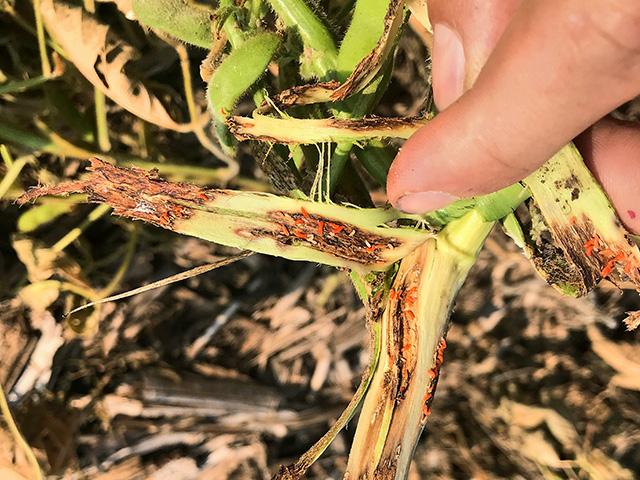Gall Midge Infests 155 Counties
Soybean Gall Midge Gains Ground
DECATUR, Ill. (DTN) -- Soybean gall midge continues to spread in select states. As of Aug. 18, 2022, there are 155 counties documented as infested with gall midge within the states of Iowa, Minnesota, Missouri, Nebraska and South Dakota.
So far in 2022, gall midge has infested eight new Iowa counties, five new counties in South Dakota and two new counties in Nebraska.
University entomologists have made tremendous progress in unlocking the secrets of gall midge since it first emerged as problematic in 2018. Discovering the adult version of the pest was a big breakthrough that allowed scouting and subsequent tracking of pest behavior. Treatments remain elusive, but entomologists are working across state lines to address the issue through a multi-university effort called The Soybean Gall Midge Alert Network (https://soybeangallmidge.org/…).
Iowa State University entomologist Erin Hodgson told DTN it is difficult to know if the midges are spreading across the landscape or if scouts are getting good at finding them. That doesn't change the fact that the pest is slowly but steadily gaining territory.
"My lab spends a lot of time looking at fields," said Hodgson. "They found midges (larvae) in new counties this year, but at very low levels. I am not sure a farm/consultant would see them (larvae) and not sure they made an economic impact in central Iowa.
"But in general, soybean is an acceptable host, and we don't see any limits to the spread in Iowa," Hodgson said. "We can find them from the north to south -- representing a gradient of soil/growing conditions. I do expect to find midges moving east across Iowa over time (similar to many other field crop pests). They aren't great fliers, but they are mobile," she told DTN.
P[L1] D[0x0] M[300x250] OOP[F] ADUNIT[] T[]
Iowa now has 42 counties confirmed with gall midge, nearly half the state. To see the distribution of the pest, visit https://soybeangallmidge.org/….
HANGING OUT OVER WINTER
Midges overwinter in soybean fields and begin adult emergence in mid-June. They will seek out soybean at about the V2 growth stage to lay eggs in the fissures and cracks at the base of the soybean stem. Adult midges are not considered long-distance flyers, so new field detections are almost always confirmed along the edge rows.
The larvae are the damaging stage for soybean gall midge. Larvae feed on the tissues within the soybean stem, disrupting nutrient and water movement within the plant. At first, the stem may become dark and discolored (lesions) near the soil line. Initial symptoms can be easily confused with fungal pathogens such as Phytophthora and Rhizoctonia.
Hodgson said adult midges are so small that they are difficult to detect without specialized cages. Farmers and scouts are more likely to see the pest in the larval stage by splitting the stem at the base and looking for the presence of small maggots feeding within dying plants.
A gall may form in infected plants, which appears as a swelling, discoloration, or outgrowth of the stem. However, galls are not always observed. Infested plants quickly wilt and die or break off at the feeding site. Significant yield reductions may occur, especially at the field edge, according to an Iowa State University release by Hodgson. Read it here: https://crops.extension.iastate.edu/….
In the release, Hodgson also reported that the Iowa fields with confirmed larvae for the first time this year had low infestation levels. In general, there were also fewer plants with lesions and fewer larvae inside, according to Hodgson's report. Although the infestations probably won't result in the death of the plants in many of the fields in 2022, Hodgson said infested fields will be a source for soybean gall midge adults in 2023.
For more information on soybean gall midge, read https://crops.extension.iastate.edu/….
To receive real-time updates on gall midge activity and distribution in 2023 join here: https://soybeangallmidge.org/….
For additional DTN stories on soybean gall midge go to https://www.dtnpf.com/….
Pamela Smith can be reached at pamela.smith@dtn.com
Follow her on Twitter @PamSmithDTN
(c) Copyright 2022 DTN, LLC. All rights reserved.





